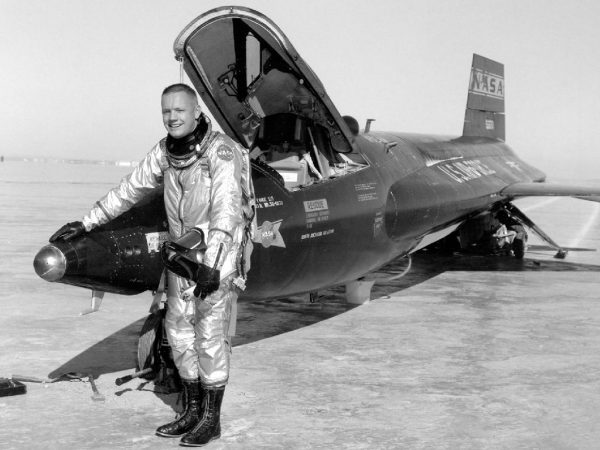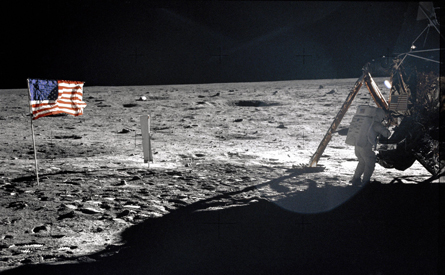The first moon walker
Editor's note: July 20, 2014 marks the 45th anniversary of the beginning moon walkway.
A little many than 40 days ago, an American astronaut climbed down the ravel of his lunar landing mental faculty — the Eagle — and became the starting time human to touch the moon's surface. As he steadied himself, he said: "That's one small step for a man, one giant leap for mankind." Around the globe, an estimated 530 million people watched on their televisions as Neil Armstrong spoken those today-famous words. On August 25, this Terra firma hero died at age 82.
Armstrong and fellow moonlight walker Edwin "Buzz" Aldrin briefly became the first ambassadors to some other world on July 20, 1969. Setting foot on another celestial body was a monolithic and breathtaking accomplishment. And Armstrong's row brought the human scale of that accomplishment to households around the world.
"Neil was among the greatest of American heroes — not just of his fourth dimension, but ever," said President Barack Obama. "When [Neil Armstrong] and his fellow crew members raised off alongside Apollo 11 in 1969, they carried with them the aspirations of an entire nation." These men showed the earthly concern "that with enough drive and ingenuity, anything is possible," the president added. And these brave individuals "delivered a moment of human achievement that leave never be forgotten."
Preparing for a life of geographic expedition
Armstrong fell in love with flying at a young age. By 15 he was already taking lessons. He picked up odd jobs around his hometown to invite flight clock time in a small airplane. He got his student's flying permit, at 16, before he got his driver's license.
In college, he trained as an aeronautical and aerospace engineer. In this field of operations, people learn how to design and control non but aircraft but also jets and other actuation systems.
But before he could finish college, Armstrong was called up for military serving. Helium communicative on to become a US Navy fighter pilot. He flew 78 combat missions in Korea. During one, his planer was polish off and he had to jump unsuccessful. It was an event that could receive killed him. But it didn't scare him off of aflare. Instead, he went back to school and finished his studies. Then he united a federal agency that would become the National Aeronautics and Space Administration, or NASA.

There, for 17 years, Neil Armstrong held a number of different jobs. He started as a run pilot for many pioneering aircraft. These included the X-15, an experimental fomite that could zoom through the standard pressure at more than 4,000 mph! He made seven flights on that quad plane, at one tip reaching an altitude of 63,198 meters (207,500 feet). That's about sixfold higher than nowadays's standard gargantuan jets. And he didn't just pilot the X-15. He also worked closely with the aircraft's engineers and designers to improve the plane's flight controls. All told, Armstrong flew more than 200 different models of aircraft, including jets, helicopters and gliders.
That all changed in 1962 when Satchmo married NASA's spaceman army corps. Suddenly, his focus became rocketry and space exploration. Within four years, he was minded the command of the Gemini 8 spacecraft, from which He controlled the first successful docking, or link, of 2 vehicles in infinite.
But the highlight of his career was Apollo 11, that famous mission to the moon. And almost 1 in 5 people cognisant at the time shared in the excitement, watching as indistinct television images showed Armstrong descendant to the lunar surface.
His team's landing module had place down in a area called the Sea of Tranquility. Within 20 proceedings, Aldrin joined him. There, the two took photos, concentrated moon rocks and set up some science experiments.
They also left mementos for upcoming space travelers. These enclosed a patch carrying the names of Vergil Grissom, Edward White and Roger Chaffee — Apollo 1 crowd members who died in a launchpad kindle. Armstrong and Aldrin as wel left-handed medals inscribed with the names of Vladimir Komarov and Yuri Alekseyevich Gagarin, two Russian astronauts (called cosmonauts) World Health Organization died during space flights in 1967 and 1968. Finally, they left a small atomic number 14 disc that carried a miniature goodwill message from 73 world leaders (its subject matter is indeed minuscule that you would need a microscope to see the row).
Armstrong walking on the synodic month first.
Aldrin returned to the Eagle after 93 minutes on the moon's control surface. Armstrong, the mission's commandant, stayed 40 minutes longer. He savored the last bits of this huge adventure. Then the pair rejoined Michael Collins aboard the Phoebus Apoll 11 space capsule for their devolve trip home. In all, the team spent more than eight years in space and traveled 953,054 miles (more 1.5 million kilometers).

Aldrin/National Aeronautics and Space Administration
And still their trip wasn't really all over. The men couldn't footstep out of their blank suits and rush to hug their families for another three weeks. Erst back out on Earth, the men had to remain in quarantine. It was a precautionary measuring rod to make a point none one had picked up a dangerous germ during their lunar trek and carried it home.
Subsequently his Apollo 11 trip to the moon, Armstrong stayed on at National Aeronautics and Space Administration and eventually pink wine to become its deputy companion administrator, in Washington, D.C. Ulterior, he became a college professor, didactics aerospace engineering. Helium then worked for several aerospace companies. It seems the man never could get sufficiency of the idea of cruising through — and occasionally outer of — Earth's atmosphere.
Afterwards his death, Armstrong's family issued a command. They aforementioned, in part: "While we mourn the loss of a very good man, we likewise celebrate his remarkable life and hope that information technology serves as an example to young people around the world to work hardened to make their dreams come true, to equal ready to research and push the limits, and to selflessly serve a cause greater than themselves."
Observes NASA Administrator Charles Bolden: "As agelong as there are history books, Neil Armstrong will be included in them, remembered for fetching human race's prime small step on a world beyond our own."
As a Deutsche Mark of respect for Armstrong and what his achievements represented, President Obama organized that flags throughout the country and at U.S. embassies beyond the sea be lowered to half-staff on the day Armstrong is buried.
Force Words
aerospace A research field devoted to the study of World's aura and the space on the far side or to aircraft that travel in the atmosphere and distance.
astronautics A research sphere specializing in the design and construction of aircraft — including those created for space go under.
Apollo missions NASA's third human space travel program. IT sought to develop the technologies needful for long-distance spacefaring. It got a big kick-start after President John F. Kenned proposed in 1961 creating the public goal of "landing a man connected the Moon and reversive him safely to the Earth."
astronaut People trained to go under into space for enquiry and geographic expedition.
supernal body Whatever naturally tensile objects of substantial size in space. Examples include comets, asteroids, planets, moons, stars and galaxies.
cosmonaut State term for spaceman.
dockage The act of bringing together and inserting unity thing into other.
engineer An individual who applies science to unimaginative purposes, such as the design or ontogeny of machines, structures or systems.
lander A peculiar, teensy-weensy vehicle fashioned to ferry mankind between a spacecraft and the celestial body they will explore.
lunar Relating to Earth's Moon.
propulsion The act or process of driving something forward, using a force. For instance, jet engines are one type of propulsion for holding airplanes aloft.

0 Response to "The first moon walker"
Post a Comment